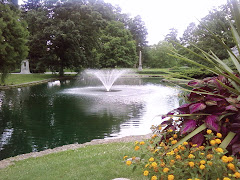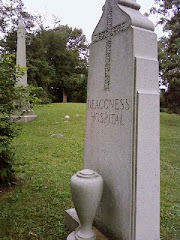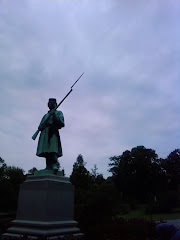In my first reflection on cemeteries, my initial feelings, ideas, and experiences were solely based upon death. It can certainly be natural for cemeteries to evoke powerful feelings of mourning and sorrow. However, from what I have learned in the past two months of meditative and experiential study is that cemeteries are not just a place to bury the dead. In my experience at Spring Grove cemetery, I’ve learned that a cemetery is alive and full of history, art, nature, and spirituality.
A cemetery is wise and full of history. The stones though cold and stiff in texture, tell stories that are both lively and dynamic. Every gravestone bestows some insight on the presence of a person’s life and the time they’ve spent on this earth. I did not feel this way, however, when I first entered the cemetery. I always felt, that the names and the dates on these stones were sort of like the names and the dates in history class – there are just as many and they’re almost impossible to remember. But through realizing I am an individual, who will eventually fall victim to my own time of death, I’ve truly become more connected to the names and dates on each of the stones. To express this idea without ambiguity, I, like the many buried in Spring Grove cemetery, will at some point have a gravestone with my name etched into the rock, along with my two most essential dates – my date of birth and my date of death. When I die, someone will dig a hole for me and lower my body down in a casket, and the people who knew me well enough will come to watch and mourn this event. As time passes these people will receive their own gravestone to write their names on and, hopefully, they will be buried somewhere close to where I am. Because of this idea I’ve found that I am connected by the graves in the cemetery, through the history of each life lived. Although there are some graves that seem to tell more history than others, for example, the Dexter or the Burnet mausoleum, I’ve found that the real history is the history that the dead take with them - it a history of their lives and the people they’ve touched. Although I have not gained a sixth sense and can now talk to the dead, these past nine weeks have allowed me to feel somewhat connected to the people who came before me and the overall significance they had in life, including the people they’ve touched, the experiences they’ve had, and the hardships they’ve endured. This has given me an overall respect for my life and the history of the names and dates on the stones in Spring Grove cemetery.
A cemetery is also an inspiring work of art. Adolph Strauch was a man who believed a cemetery should look more like a beautiful composition rather than just a motley arrangement of stones. This is why the graves and the mausoleums in Spring Grove cemetery act as sculptures on its grassy, three-dimensional canvass. I felt this picturesque quality of the cemetery made it look less like a graveyard and something more along the lines of a scene inspired by the Garden of Eden. Some of the sculpted gravestones, like the Bragg monument, make the overall cemetery look like a work of art. I feel astonished with the fact that people would take so much time out of their life to make a cemetery look beautiful. It makes me think of all the powerful works of art mankind has created and how much time it must have taken to construct them. I personally have yet to experience looking up at the Sistine Chapel, but I feel Spring Grove offers at least some of that same kind of awe and marvel in its own works. This contributes to the overall idea of the cemetery being a work of art and how truly alive the cemetery is.
A cemetery is also wild and full of nature. Over the course of my experience, I was highly impressed with all of nature Spring Grove cemetery had to offer. The lakes scattered throughout the cemetery make it look serene, but all the flora and greenery that surround these bodies of water make the entire cemetery come alive. The trees in the cemetery grow wild in some parts and the woodland area is thick and kept in its natural state. I felt the champion trees, with their impressively immense trunks, were certainly something that contributed to the natural spirit of the cemetery. Also, the flora brightened cemetery and was everywhere. The fact that most cemeteries, funeral processions, and burials use a lot of flowers made me think that somehow the idea of nature and the cemetery is connected. This leads me to believe that the cemetery is supposed to be reflective of nature and the overall aspect of life.
A cemetery is also meaningful and full of spirituality. Spirituality in the deepest sense of the word has nothing to do with religion. Moreover, it is the human relationship to anything beyond bodily senses, time, and the material world. During my experience, I’ve felt certain characteristics of spirituality and I believe Spring Grove works to support this for everyone who spends time there. One thing I’ve found particularly spiritual about the cemetery is that the sense of time completely escaped me during my visits. Even near the front gate, there are clocks on the buildings without hands, symbolizing that time has no meaning in the cemetery. Also, the fact that the cemetery has no distractions from the outside world leads me to believe that the cemetery is quite spiritual. I did not have to feel any sense of worry or anxiety, but it was rather a place I could just be. I would not describe my experience at Spring Grove cemetery with sense of numbness either, but it just feels like a place to be alive and to focus on life. I find that it is this idea of spirituality that makes the cemetery truly come alive.
During my experience I’ve found that cemeteries are not just a place to bury the dead, but they are a place that is full of life. Although this place can certainly evoke feelings of sadness or sorrow it is also full of history, art, nature, and spirituality, which are elements that seem to indicate that it is bursting with life. Perhaps a cemetery is more alive than the outside world of its society. Overall, I feel that Spring Grove cemetery and the idea of the cemetery in society is a celebration of the human condition and it is made to be enjoyed by the living.

































